Next to creative content marketing, influencer campaigns, and paid social, email might not seem like the sexiest marketing tactic, but it works.
In fact, 174% more conversions are driven by email than social media, and email marketing delivers an average return-on-investment of $44 for every $1 spent. That’s a 4400% ROI – way above what you’d expect to see from almost any other channel.
But with 2.8 million emails being sent every second, it’s vital that your marketing communications cut through the noise. That means tailoring your messages and content to fit the needs of your audience via effective email list management.
What does “good” email list management look like?
Quality email list management holds the key to intelligent audience segmentation, which in turn opens up the possibility of more effective personalization. This is well worth your while. According to Experian, personalized email campaigns can generate six times higher transaction rates and revenue per email vs. non-personalized emails.
“Good” email list management is all about fulfilling two critical components:
- High engagement – a huge email database is of little use if no one reads the emails you send.
- Low churn – whether through unsubscriptions, hard bounces, or people reporting you as spam, some churn is always going to happen. Your job is to keep it at a manageable level.
How to manage your lists effectively
By now, the benefits of maintaining a well-managed email list should be clear. To step up your list management game, follow our guide (including examples of brands that are already nailing it).
1. Make a positive first impression
The job of managing your email list begins the first time you reach out to a new subscriber.
A positive first impression paves the way for a long and valuable relationship. But don’t expect your new would-be customer to stick around for long if you get it wrong; one-third of all subscribers to program email lists are lost within the 30 days after sign-up.
Welcome emails are therefore extremely important. They’re a fantastic way to clarify what the customer can expect in terms of content, brand voice, special offers, and more. Send one as soon as someone signs up to your email list.
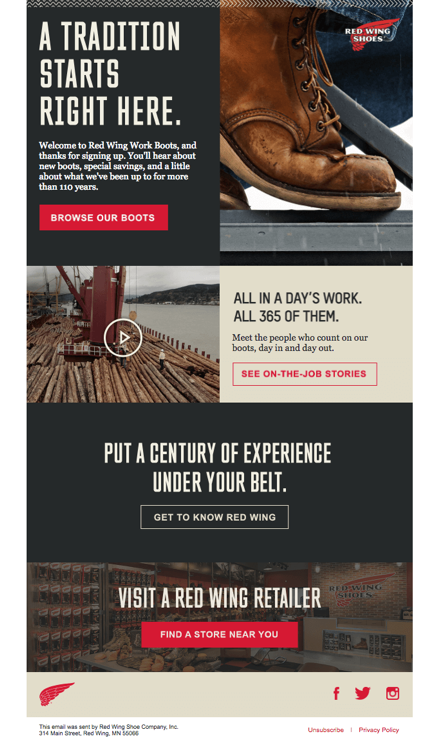
Short and to the point, this introductory email succinctly welcomes the subscriber, thanks them for signing up, and tells them about the sort of content they’ll receive going forward. Again, there’s nothing pushy here, but there are four well-integrated CTAs leading to content that promotes the brand’s values and history, plus links to its online and brick-and-mortar stores.
2. Hand control to your subscribers
Let’s consider what prompts people to unsubscribe from emails. According to MarketingSherpa, the biggest reasons are as follows:
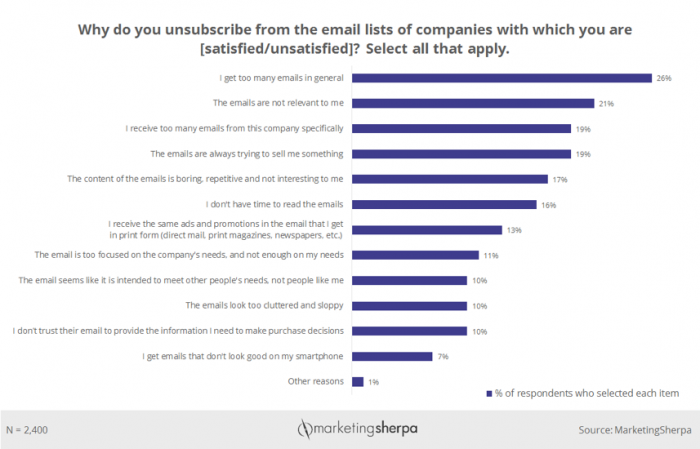
More than half of these factors are directly related to email volume and content. They wouldn’t be an issue if the brands in question allowed subscribers to set their own preferences around the content they receive, and the frequency at which they receive it.
The takeaway here is simple: give your subscribers control over what you send them, and they’re far less likely to ditch you.
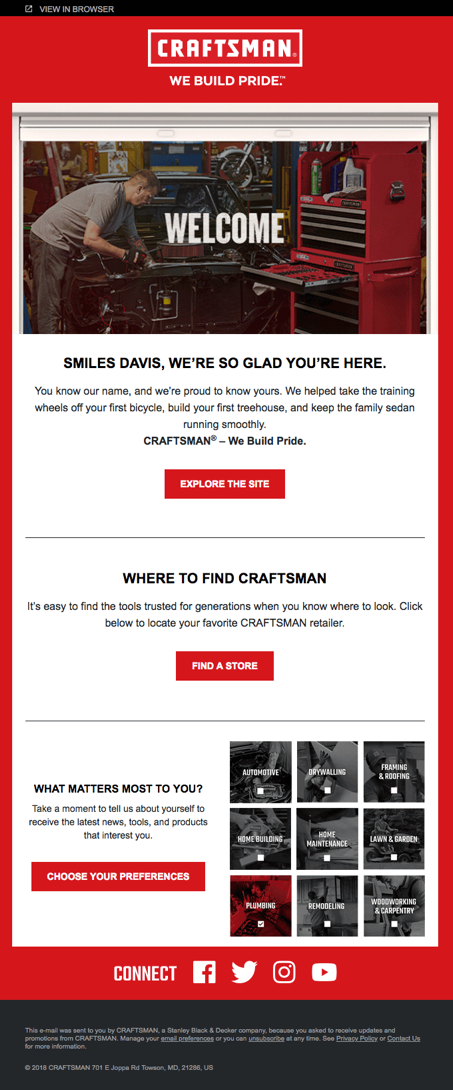
First off, Craftsman does a brilliant job of building an emotional connection around its products – not necessarily easy to do when it comes to plumbing, construction, or drywalling projects. But most importantly, in the “What matters most to you?” section, it lets subscribers tailor future emails to their exact requirements. Why second-guess what a customer wants when you can just ask them?
3. Maintain impeccable list hygiene
Not all of that churn is down to people actively unsubscribing. A significant chunk comes from so-called hard and soft bounces:
- Hard bounces occur when an email is sent to an invalid account. Sometimes people will have entered their details wrong, but it’s more likely due to subscribers moving jobs (and thus getting a new work email) or deactivating old accounts.
- Soft bounces, on the other hand, crop up when an email account still exists but is consistently unable to receive messages. This might happen for a number of reasons, such as the server being down or the mailbox being full.
Whatever the reason, it’s important to regularly – say, once per month – remove these bouncing accounts from your email list.
Verifying your email list regularly will help you maintain a strong sender score. If your score drops too low, ISPs may choose to dump your emails in spam folders, or refuse to deliver them altogether.
4. Win over your unengaged subscribers
Convincing consumers to hand over their email address is only part of the battle. Next, you need them to actually open your messages.
Given the volume of emails sent every day, you probably won’t be surprised to learn that just a third of email subscribers are classified as “engaged” (i.e. they actively open and click on email campaigns).
Accounts that literally never engage with you should be treated much the same as hard and soft bounces. But before you purge them from your email list completely, run a re-engagement campaign targeting users that haven’t opened or clicked an email from you within a set period of time (say six months or a year).
Keep it simple. Ask if they want to continue receiving emails from you; prompt them to opt in again; send them a targeted offer; anything that encourages them to interact with your messages in the future.
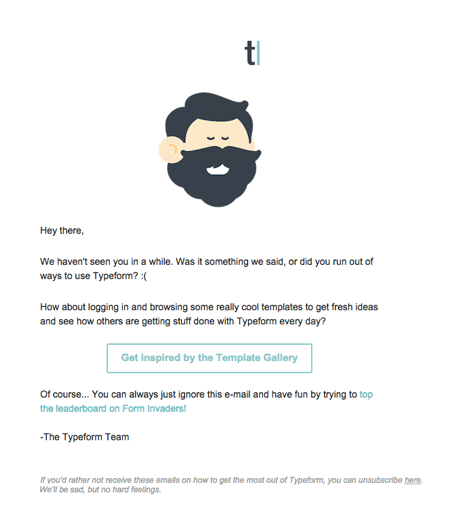
Once again, simple is often best. Typeform is crystal-clear in its intentions here, prompting users who haven’t logged in for a while to seek out inspiration on new ways to use its service. There’s also a link to Typeform’s extremely addictive Form Invaders game – a great tactic for gently re-engaging lapsed subscribers.
5. Don’t make it hard to unsubscribe
As anyone who’s stayed friends with an ex-partner will understand, there can be such a thing as a good breakup.
While churn is a broadly negative thing, if someone does want to unsubscribe, make sure it’s easy for them to find the “opt out” button in your emails. And make sure you send them on their way with a friendly farewell rather than forcing them to endure a byzantine series of clicks, follow-up emails, and terms and conditions. You may even convince them to opt in to a different type of subscription (e.g. weekly rather than daily) instead of unsubscribing.
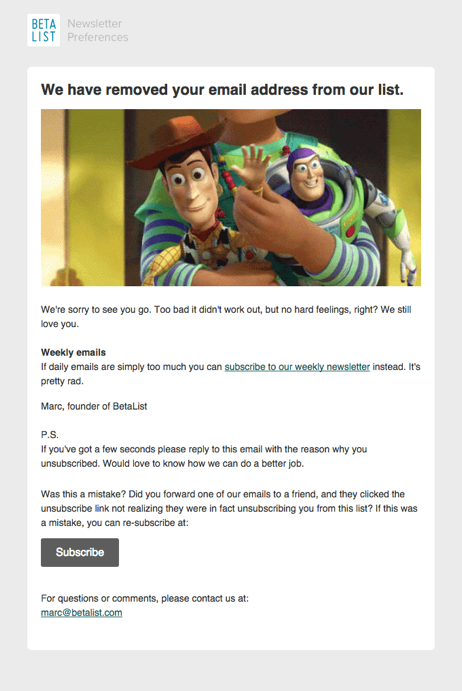
“No hard feelings” is very much the message here (it’s literally in the copy). But there are also two opportunities for users to remain subscribed – either by reducing the volume of emails they receive, or by resubscribing for users who opted out in error. Full marks for the Toy Story image, too – we’re sure this has guilt-tripped plenty of would-be unsubscribers into changing their mind at the last minute.
Do you have any email list management tips to add to this list? Feel free to share in the comments below: